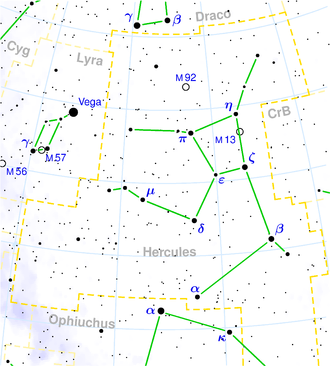NGC 6490
| Galaxy NGC 6490 |
|
|---|---|
|
|
|
| AladinLite | |
| Constellation | Hercules |
|
Position equinox : J2000.0 , epoch : J2000.0 |
|
| Right ascension | 17 h 54 m 30.467 s |
| declination | + 18 ° 22 ′ 33.00 ″ |
| Appearance | |
| Morphological type | S0-? |
| Brightness (visual) | 13.9 likes |
| Brightness (B-band) | 14.9 mag |
| Angular expansion | 1.0 ′ × 0.8 ′ |
| Position angle | 115 ° |
| Surface brightness | 13.7 mag / arcmin² |
| Physical data | |
| Affiliation | WBL 649 |
| Redshift | 0.010821 ± 0.000087 |
| Radial velocity | 3244 ± 26 km / s |
|
Stroke distance v rad / H 0 |
(152 ± 11) · 10 6 ly (46.6 ± 3.3) Mpc |
| history | |
| discovery | Albert Marth |
| Discovery date | May 11, 1864 |
| Catalog names | |
| NGC 6490 • UGC 11033 • PGC 61079 • CGCG 112-068 • CGCG 113-002 • MCG + 03-45-038 • 2MASX J17543046 + 1822333 • GC 5885 • WISEA J175430.47 + 182233.0 • LDCE 1274 NED003 | |
NGC 6490 is a 14.3 mag bright lenticular galaxy of the Hubble type E / S0 in the constellation Hercules in the northern sky . It is an estimated 152 million light years from the Milky Way and about 45,000 light years in diameter. Presumably it forms a gravitationally bound galaxy pair together with NGC 6495 .
In the same area of the sky are u. a. the galaxies NGC 6500 and NGC 6501 .
The object was discovered by Albert Marth on May 11, 1864 .
Web links
- NGC 6490. SIMBAD , accessed August 7, 2019 .
- NGC 6490. DSO Browser, accessed August 7, 2016 .
- Auke Slotegraaf : NGC 6490. Deep Sky Observer's Companion, accessed on August 7, 2016 (English).
